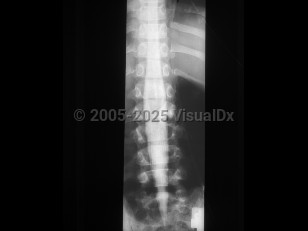- SCM type 1 consists of two hemicords, each with its own dural sheath, separated by a bony or cartilaginous septum.
- SCM type 2 consists of two hemicords within the same dural sheath but separated by a fibrous septum.
Diastematomyelia in Adult
Alerts and Notices
Important News & Links
Synopsis

Diastematomyelia, split-cord malformation (SCM), is a rare congenital abnormality in which there is partial or complete cleft in the spinal cord by a sagittal osseous or fibrous septum. It is seen predominantly in females, most often affecting the lower thoracic or upper lumbar segments. Clinically, diastematomyelia often presents as tethered cord syndrome (back pain, abnormal gait, spasticity, bowel / bladder incontinence) in children or young adults, although symptom onset may occur at any age. Patients may have a midline cutaneous abnormality such as a hairy patch or dimple over the affected area. There are two classifications:
Codes
ICD10CM:
Q06.2 – Diastematomyelia
SNOMEDCT:
445308004 – Split spinal cord malformation
Q06.2 – Diastematomyelia
SNOMEDCT:
445308004 – Split spinal cord malformation
Look For
Subscription Required
Diagnostic Pearls
Subscription Required
Differential Diagnosis & Pitfalls

To perform a comparison, select diagnoses from the classic differential
Subscription Required
Best Tests
Subscription Required
Management Pearls
Subscription Required
Therapy
Subscription Required
References
Subscription Required
Last Reviewed:08/07/2018
Last Updated:01/13/2022
Last Updated:01/13/2022

